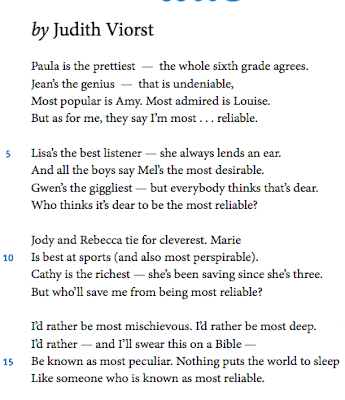Hello sixth graders, I trust your Thanksgiving was restful and that you enjoyed your turkey. I happily watched the Dallas Cowboys beat the Oakland Raiders. WOOT WOOT! I was a little disappointed to see the Baltimore Ravens beat the Pitsburgh Steelers, but only because I used to live in Pittsburgh.
Now here is a bit of information to help you study for your post test. Memorize and think of examples from Judith Viorst's poem "Who's Who" to help you.
Rhyme Scheme=The pattern of rhyming words in a poem or song.
Alliteration=The repetition of consonant sounds in words that are close together in literature.
Alliteration:
Alliteration is the repetition of consonant sounds in literature.
Answer the following questions. Tweet your responses to #alliterationjv or respond in the comments section.
What are some examples of alliteration from the poem?
Can you find two words that do not begin with the same letter, but have the same sound?
Find one example of alliteration using the m sound.
Rhyme Scheme: Take a look at the poem above. What are some words that rhyme? Remember, rhyming words usually sound the same at the end of the word, right? Tweet your response to #who'swhorhymes or enter your answer in the comment section below.
In class we assigned letters in each stanza to words that rhyme.
Check out the first stanza:
What are the words that rhyme at the ends of the lines?
We assign the lines a letter based on the words that rhyme in order of the alphabet.
Agrees rhymes with Louise so we name or assign lines 1 and 3 the letter A.
Undeniable rhymes with reliable so we assign lines 2 and 4the line B.
The rhyme scheme tells us which LINES rhyme with with which lines. The rhyme scheme for stanza one is ABAB.
With a new stanza, there are new rhyming words so we assign new letters to the new stanza. Let's take a look at stanza 2:
Find the rhyming words and assign new letters to the lines containing rhyming words. Remember to assign new letters to the lines. What is the rhyme scheme. Include your reply on Twitter, via email (nleary@hawaii.edu).
Point of View=The vantage point from which a story or narrative is being told.
In the first person point of view the narrator, the person telling the story, is a character in the story. The pronouns used to describe himself or herself and others around him or her include I, me, us, we, my. One way to remember the first person narrative is I=1st person
In third person point of view, the narrator is telling the story from the outside, Perhaps he is watching the scenario from far away. The pronouns used to describe third person are he, she, they, etc. One way to remember third person is Three=she or he.
Here is a link to Haiku learning for a bit more information and some practice worksheets that you can print and try on your own for practice.
www.myhaikuclass.com/nwleary/owlenglish/cms_page/view.
Thanks for visiting my blog and I'll see you on campus at CKMS! I am looking forward to reading your responses on twitter, in comments or via email!
A hui ho!




